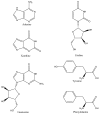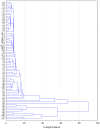Honey as Source of Nitrogen Compounds: Aromatic Amino Acids, Free Nucleosides and Their Derivatives
- PMID: 32075114
- PMCID: PMC7070497
- DOI: 10.3390/molecules25040847
Honey as Source of Nitrogen Compounds: Aromatic Amino Acids, Free Nucleosides and Their Derivatives
Abstract
The content of selected major nitrogen compounds including nucleosides and their derivatives was evaluated in 75 samples of seven varieties of honey (heather, buckwheat, black locust, goldenrod, canola, fir, linden) by targeted ultra-high performance liquid chromatography-diode array detector - high-resolution quadrupole time-of-flight mass spectrometry (UHPLC-DAD-QqTOF-MS) and determined by UHPLC-DAD. The honey samples contained nucleosides, nucleobases and their derivatives (adenine: 8.9 to 18.4 mg/kg, xanthine: 1.2 to 3.3 mg/kg, uridine: 17.5 to 51.2 mg/kg, guanosine: 2.0 to 4.1 mg/kg; mean amounts), aromatic amino acids (tyrosine: 7.8 to 263.9 mg/kg, phenylalanine: 9.5 to 64.1 mg/kg; mean amounts). The amounts of compounds significantly differed between some honey types. For example, canola honey contained a much lower amount of uridine (17.5 ± 3.9 mg/kg) than black locust where it was most abundant (51.2 ± 7.8 mg/kg). The presence of free nucleosides and nucleobases in different honey varieties is reported first time and supports previous findings on medicinal activities of honey reported in the literature as well as traditional therapy and may contribute for their explanation. This applies, e.g., to the topical application of honey in herpes infections, as well as its beneficial activity on cognitive functions as nootropic and neuroprotective, in neuralgia and is also important for the understanding of nutritional values of honey.
Keywords: essential and non-essential nutrients; honey composition; neuropharmacological activities; nucleosides; uridine.
Conflict of interest statement
The author declare no conflicts of interest.
Figures



Similar articles
-
Nitrogen compounds in Phacelia tanacetifolia Benth. honey: First time report on occurrence of (-)-5-epi-lithospermoside, uridine, adenine and xanthine in honey.Food Chem. 2018 Jul 30;255:332-339. doi: 10.1016/j.foodchem.2018.02.093. Epub 2018 Feb 17. Food Chem. 2018. PMID: 29571484
-
The determination of phenolic profiles of Serbian unifloral honeys using ultra-high-performance liquid chromatography/high resolution accurate mass spectrometry.Food Chem. 2013 May 1;138(1):32-40. doi: 10.1016/j.foodchem.2012.10.025. Epub 2012 Nov 2. Food Chem. 2013. PMID: 23265452
-
Amino acids profile of Serbian unifloral honeys.J Sci Food Agric. 2013 Oct;93(13):3368-76. doi: 10.1002/jsfa.6187. Epub 2013 Jun 5. J Sci Food Agric. 2013. PMID: 23606039
-
A review on the nucleic acid constituents in mushrooms: nucleobases, nucleosides and nucleotides.Crit Rev Biotechnol. 2018 Aug;38(5):762-777. doi: 10.1080/07388551.2017.1399102. Epub 2017 Nov 10. Crit Rev Biotechnol. 2018. PMID: 29124970 Review.
-
Neurological effects of honey: current and future prospects.Evid Based Complement Alternat Med. 2014;2014:958721. doi: 10.1155/2014/958721. Epub 2014 Apr 27. Evid Based Complement Alternat Med. 2014. PMID: 24876885 Free PMC article. Review.
Cited by
-
The Isorhamnetin-Containing Fraction of Philippine Honey Produced by the Stingless Bee Tetragonula biroi Is an Antibiotic against Multidrug-Resistant Staphylococcus aureus.Molecules. 2021 Mar 17;26(6):1688. doi: 10.3390/molecules26061688. Molecules. 2021. PMID: 33802916 Free PMC article.
-
Analysis of 18 Free Amino Acids in Honeybee and Bumblebee Honey from Eastern and Northern Europe and Central Asia Using HPLC-ESI-TQ-MS/MS Approach Bypassing Derivatization Step.Foods. 2022 Sep 7;11(18):2744. doi: 10.3390/foods11182744. Foods. 2022. PMID: 36140872 Free PMC article.
-
¹H-NMR Metabolic Profiling, Antioxidant Activity, and Docking Study of Common Medicinal Plant-Derived Honey.Antioxidants (Basel). 2022 Sep 22;11(10):1880. doi: 10.3390/antiox11101880. Antioxidants (Basel). 2022. PMID: 36290603 Free PMC article.
-
Application of Liquid Chromatography-Mass Spectrometry-Based Untargeted Metabolomics to Reveal Metabolites Related to Antioxidant Activity in Buckwheat Honey.Molecules. 2025 May 17;30(10):2198. doi: 10.3390/molecules30102198. Molecules. 2025. PMID: 40430370 Free PMC article.
-
Analysis of Free Amino Acid Composition and Honey Plant Species in Seven Honey Species in China.Foods. 2024 Mar 29;13(7):1065. doi: 10.3390/foods13071065. Foods. 2024. PMID: 38611369 Free PMC article.
References
-
- Dorland W.A.N. Dorland’s Medical Dictionary. 32nd ed. Elsevier; Philadelphia, PA, USA: 2007.
MeSH terms
Substances
Grants and funding
LinkOut - more resources
Full Text Sources

